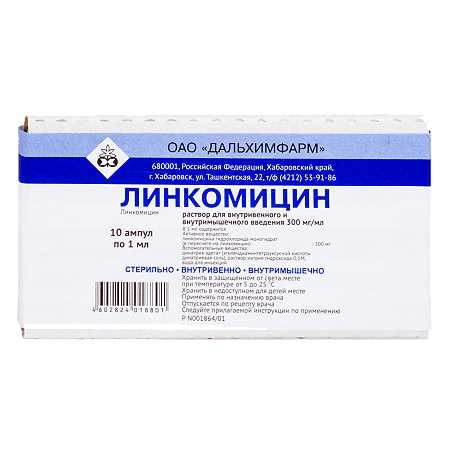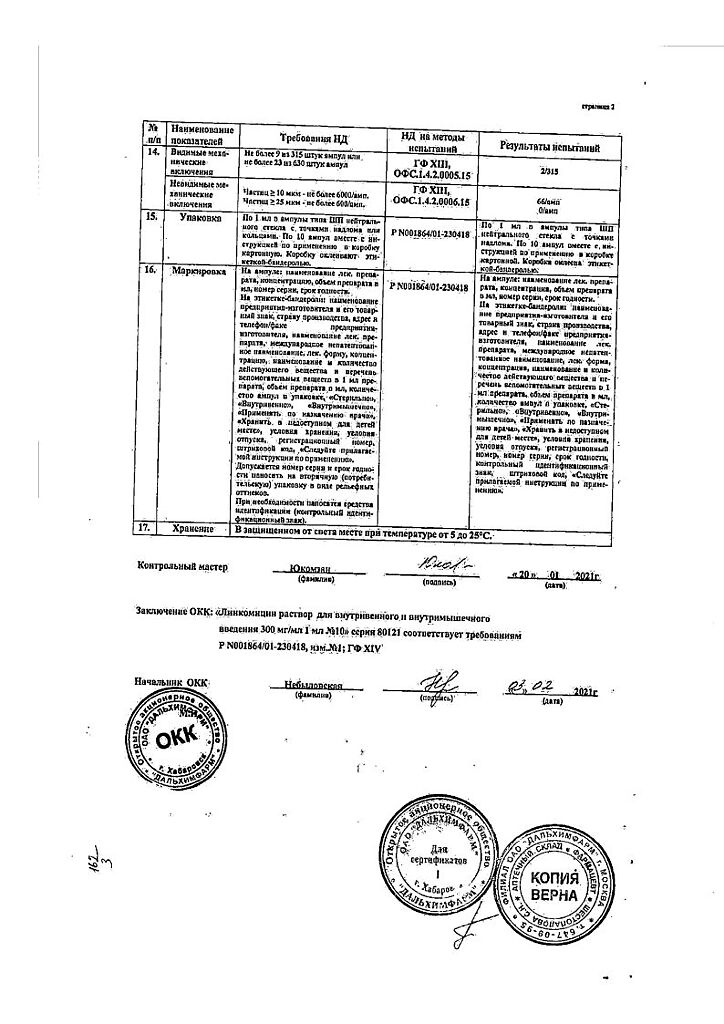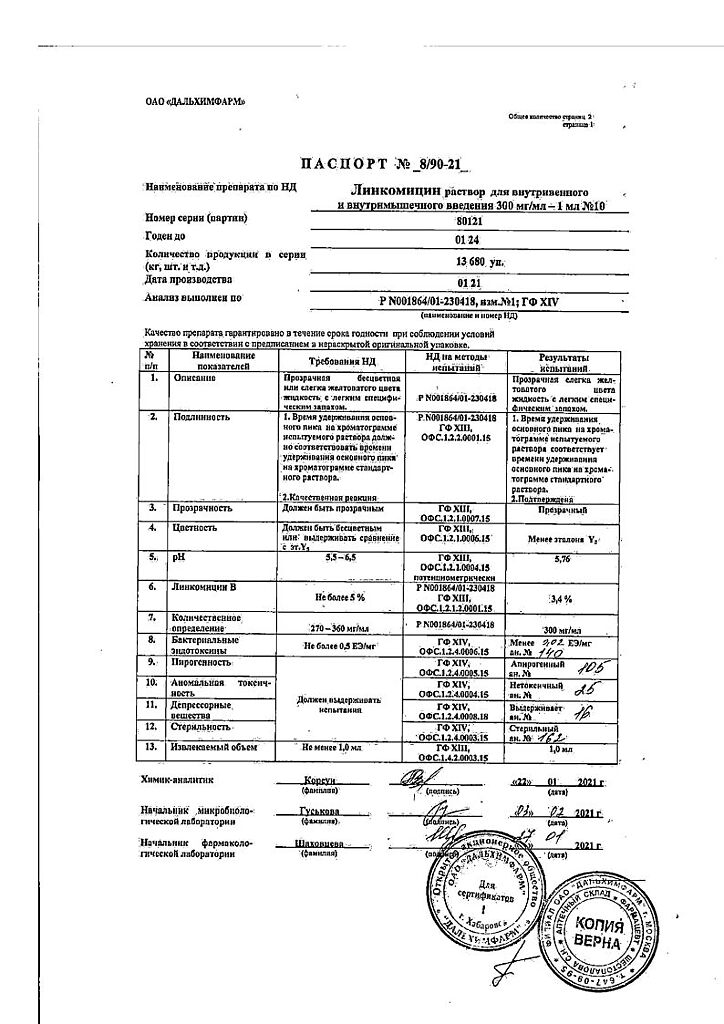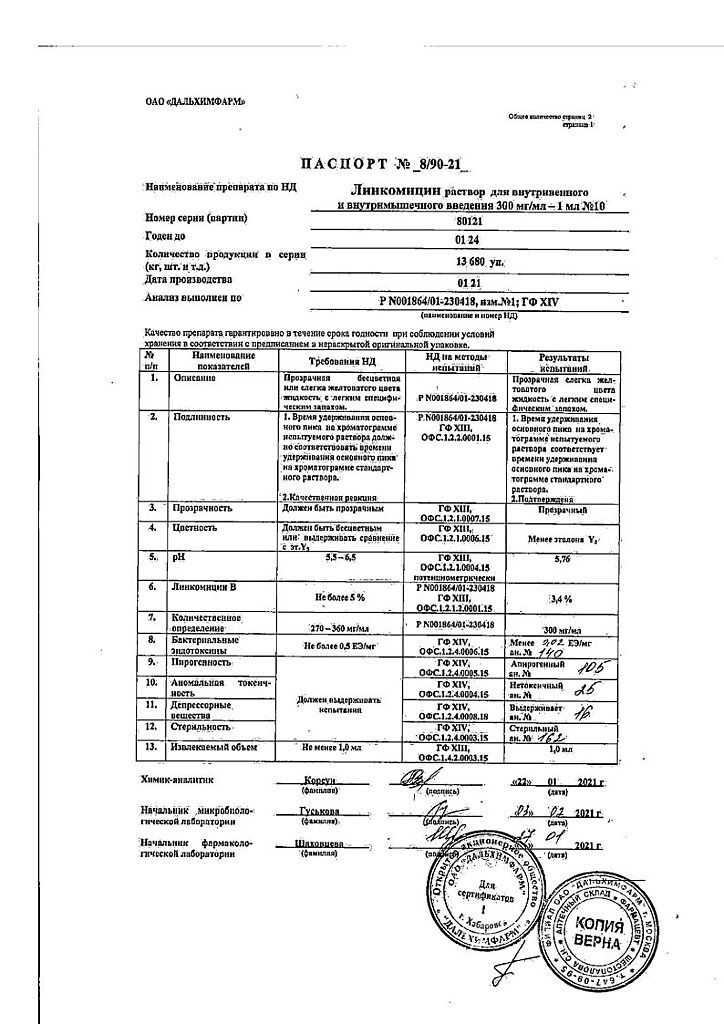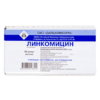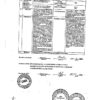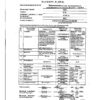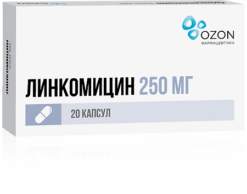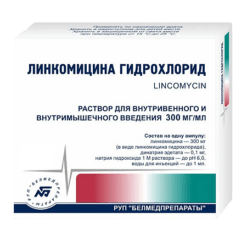No products in the cart.
Lincomycin, 300 mg/ml 1 ml 10 pcs
€4.68 €4.16
Description
Pharmacological action
An antibiotic of the lincosamide group. It has a bacteriostatic effect in therapeutic doses. At higher concentrations it has a bactericidal effect. It inhibits protein synthesis in the microbial cell. It is active mainly against Gram-positive bacteria: aerobic – Staphylococcus spp. (including producing penicillinase); Streptococcus spp. including Streptococcus pneumoniae (except Enterococcus faecalis), Corynebacterium diphtheriae, anaerobic spore-forming bacteria Clostridium spp. Lincomycin is also active against Gram-negative anaerobic bacteria: Bacteroides spp., Mycoplasma spp. Most gram-negative bacteria, fungi, viruses, protozoa are not sensitive to lincomycin. Resistance develops slowly. There is cross-resistance between lincomycin and clindamycin.
After parenteral administration the drug is rapidly distributed in tissues and body fluids, except for cerebrospinal fluid, high concentrations are achieved in bone tissue, bile, urine.
Lincomycin passes through the placenta, penetrates into breast milk.
Protein binding decreases with increasing concentration.
The elimination half-life:
The normal half-life is 5.4 hours (4-6 hours). However, this period may be prolonged in case of liver and/or kidney dysfunction.
The time of reaching maximum plasma concentration:
In intramuscular administration, 0.5 hours;
In intravenous administration, by the end of the infusion.
Extraction: with the kidneys and bile. After intramuscular administration of the drug during 24 hours on the average 10-47% of dose is excreted unchanged in the urine, after intravenous administration – 13-72% of dose. During hemodialysis the drug is not removed from the blood.
Indications
Indications
Lincomycin is used in the treatment of septic conditions caused by staphylococci and streptococci, acute and chronic osteomyelitis, pneumonia, purulent skin and soft tissue infections, rust inflammation, otitis media and other infections caused by microorganisms sensitive to this antibiotic, especially in infections caused by microorganisms resistant to penicillins and other antibiotics and also in allergies to penicillins.
Because lincomycin accumulates in bone tissue, it is one of the most effective drugs in the treatment of acute and chronic osteomyelitis and other infectious lesions of bones as well as joints.
Active ingredient
Active ingredient
Composition
Composition
Lincomycin hydrochloride monohydrate in terms of lincomycin base – 300 g.
Auxiliary substances:
Dinatrium salt of ethylenediaminetetraacetic acid (trilon B), sodium hydroxide solution, water for injection up to 1 liter.
How to take, the dosage
How to take, the dosage
Lincomycin hydrochloride is used intramuscularly and intravenously.
The daily dose for adults with parenteral administration is 1.8 g, single dose – 0.6 g. In severe course of infection daily dose may be increased up to 2.4 g. The drug is administered 3 times a day at 8-hour intervals. In children the daily dose is 10-20 mg/kg regardless of age.
Intravenous lincomycin hydrochloride is administered only by drip at a rate of 60-80 drops per minute. Before administration, 2 ml of 30% antibiotic solution (0.6 g) shall be diluted with 250 ml of isotonic sodium chloride solution. Intravenous injection without prior dilution is not allowed.
The treatment duration is 7-14 days; with osteomyelitis the course of treatment is up to 3 weeks or more.
Patients with renal-hepatic insufficiency are prescribed parenterally in a daily dose not exceeding 1.8 g with 12-hour intervals between injections.
Interaction
Interaction
In concomitant use with penicillins, cephalosporins, chloramphenicol or erythromycin antagonism of antimicrobial action is possible, with aminoglycosides – synergism of action.
In concomitant use with agents for inhalation anesthesia or peripheral myorelaxants an increase in neuromuscular blockage is noted up to development of apnea.
Pharmaceutical interactions: lincomycin is incompatible with kanamycin, novobiocin, barbiturates, theophylline, calcium gluconate and magnesium sulfate.
Special Instructions
Special Instructions
In long-term use of the drug, systematic monitoring of renal and hepatic function is required. Administration to patients with hepatic impairment is allowed only for vital indications.
In case of pseudomembranous colitis, lincomycin should be discontinued and vancomycin or bacitracin should be prescribed.
In order to avoid development of a thickening at the injection site and aseptic abscess, the drug should be injected deeply intramuscularly.
Contraindications
Contraindications
Side effects
Side effects
Digestive system disorders: nausea, vomiting, epigastric pain, diarrhea, glossitis, stomatitis; transient increase in plasma liver transaminases and bilirubin; pseudomembranous colitis may develop with long-term use in high doses.
Hematopoietic system disorders: reversible leukopenia, neutropenia, thrombocytopenia, agranulocytosis, and in rare cases aplastic anemia and pancytopenia.
Allergic reactions: urticaria, exfoliative dermatitis, Quincke’s edema, anaphylactic shock.
The effects caused by chemotherapeutic action: candidiasis.
Local reactions: local irritation, soreness, formation of a lump and sterile abscess may occur with intramuscular injection. Thrombophlebitis is possible with intravenous injection.
Others: decreased blood pressure, dizziness, weakness (with rapid intravenous injection).
Similarities
Similarities
Additional information
| Shelf life | 3 years |
|---|---|
| Conditions of storage | In a light-protected place at 5-25 °C. |
| Manufacturer | Dalkhimpharm, Russia |
| Medication form | Infusion and intravenous solution |
| Brand | Dalkhimpharm |
Other forms…
Related products
Buy Lincomycin, 300 mg/ml 1 ml 10 pcs with delivery to USA, UK, Europe and over 120 other countries.

